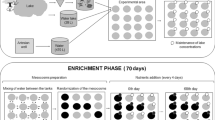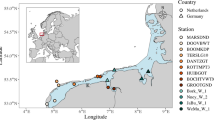Abstract
A new phytoplankton metric is presented, which is developed from a large dataset of Norwegian lakes (>2,000 samples from >400 lakes). In contrast to previous metrics, this index is not built on selected ‘indicative’ taxa, but uses all available taxonomic information at genus and species level. Taxa optima with respect to lake trophic status (derived from total phosphorus concentrations) are used to calculate a phytoplankton trophic index (TI) for each sample. Analysis of the TI shows that phytoplankton communities exhibit highly non-linear responses to eutrophication in Norwegian lakes. Reference lakes are characterized by very similar TIs despite having considerable variation in total phosphorus and chlorophyll a concentrations. TI exhibits a non-linear distribution along the eutrophication gradient which separates unimpacted from impacted sites in the study area. We further show that TI exhibits smaller seasonal variations than chlorophyll a, making it a more reliable indicator for lake monitoring. Implications for its applicability within the WFD are discussed.



Similar content being viewed by others
References
Andersen, T., 1997. Pelagic nutrient cycles: herbivores as sources and sinks. Springer, Berlin.
Brettum, P. & T. Andersen, 2005. The use of phytoplankton as indicators of water quality. NIVA-report SNO 4818-2004: 197 pp.
Carvalho, L., B. Dudley, I. Dodkins, R. Clarke, J. Jones, S. Thackeray & S. Maberly, 2007. Phytoplankton Classification Tool (Phase 2). Final report. Edinburgh, Scotland & Northern Ireland Forum for Environmental Research: 94 pp.
Directive, 2000. Directive 2000/60/EC of the European Parliament and of the council of 23 October 2000 establishing a framework for community action in the field of water policy. Official Journal of the European Communities L327: 1–72.
Henriksen, A., B. L. Skjelkvale, J. Mannio, A. Wilander, R. Harriman, C. Curtis, J. P. Jensen, E. Fjeld & T. Moiseenko, 1998. Northern European Lake Survey, 1995—Finland, Norway, Sweden, Denmark, Russian Kola, Russian Karelia, Scotland and Wales. Ambio 27: 80–91.
Koenker, R., 2008. Quantreg: quantile regression. R package version 4.20. http://www.r-project.org.
Lyche Solheim, A., S. Rekolainen, J. Moe, L. Carvalho, G. Phillips, R. Ptacnik, E. Penning, L. G. Toth, C. O’Toole, A.-K. Schartau & T. Hesthagen, 2008. Ecological threshold responses in European lakes and their applicability for WFD implementation—synthesis of lakes results from the REBECCA project. Aquatic Ecology 42: 317–334.
Mitchell, T. & P. Jones, 2005. An improved method of constructing a database of monthly climate observations and associated high-resolution grids. International Journal of Climatology 25: 693–712.
Moe, S. J., B. Dudley & R. Ptacnik, 2008. REBECCA databases: experiences from compilation and analyses of monitoring data from 5000 lakes in 20 European countries. Aquatic Ecology 42: 183–201.
Ptacnik, R., A. G. Solimini, T. Andersen, T. Tamminen, P. Brettum, L. Lepistö, E. Willén & S. Rekolainen, 2008a. Diversity predicts stability and resource use efficiency in natural phytoplankton communities. Proceedings of the National Academy of Sciences of the USA 105: 5134–5138.
Ptacnik, R., L. Lepistö, E. Willén, P. Brettum, T. Andersen, S. Rekolainen & A. Lyche Solheim, 2008b. Quantitative responses of lake phytoplankton to eutrophication in Northern Europe. Aquatic Ecology 42: 227–236.
R Development Core Team, 2008. R: a language and environment for statistical computing. R Foundation for Statistical Computing, Vienna, Austria [available on internet at http://www.R-project.org. ISBN 3-900051-07-0.
Reynolds, C. S., 1980. Phytoplankton assemblages and their periodicity in stratifying lake systems. Holarctic Ecology 3: 141–159.
Reynolds, C. S., 1984. The ecology of freshwater phytoplankton. Cambridge University Press, New York.
Scheffer, M., 1990. Multiplicity of stable states in freshwater systems. Hydrobiologia 200(201): 475–486.
Scheffer, M. & S. R. Carpenter, 2003. Catastrophic regime shifts in ecosystems: linking theory to observation. Trends in Ecology and Evolution 18: 648–656.
Solimini, A. G., A. C. Cardoso, J. Carstensen, G. Free, A.-S. Heiskanen, N. Jepsen, P. Nõges, S. Poikane & W. van de Bund, 2008. The monitoring of ecological status of European freshwaters. In Quevauviller, P., U. Borchers, C. Thompson & T. Simonart (eds), The Water Framework Directive: Ecological And Chemical Status Monitoring. Wiley, Chippenham, Wiltshire: 29–60.
Solimini, A. G., R. Ptacnik & A. C. Cardoso, 2009. Toward a holistic assessment of ecosystem functioning: the relationships between anthropogenic pressures, chemical and ecological status under the Water Framework Directive. Trends in Analytical Chemistry (in press).
Tikkanen, T. & T. Willén, 1992. Växtplanktonflora (Phytoplankton Flora). Swedish Environmental Protection Agency, Solna, Sweden (in Swedish).
Utermöhl, H., 1958. Zur Vervollkommnung der quantitativen Phytoplanktonmethodik. Mitteilungen der Internationalen Vereinigung für Theoretische und Angewandte Limnologie 9: 1–38.
Watson, S. B., E. McCauley & J. Downing, 1997. Patterns in phytoplankton taxonomic composition across temperate lakes of differing nutrient status. Limnology and Oceanography 42: 486–495.
Wolfram G., M. Dokulil, K. Pall., et al., 2007. Intercalibration Exercise, Technical Report + Annexes, Alpine GIG (Lakes). Vienna, Ispra.
Acknowledgements
We thank Susanne C. Schneider, Laurence Carvalho and an anonymous reviewer for comments on the manuscript. Funding by European Commission (res. project REBECCA, SSPI-CT-2003-502158) and Norwegian Research Council (res. project BIOCLASS-FRESH, 184002) are acknowledged.
Author information
Authors and Affiliations
Corresponding author
Additional information
Guest editors: P. Nõges, W. van de Bund, A. C. Cardoso, A. Solimini & A.-S. Heiskanen
Assessment of the Ecological Status of European Surface Waters
Electronic supplementary material
Below is the link to the electronic supplementary material.
Rights and permissions
About this article
Cite this article
Ptacnik, R., Solimini, A.G. & Brettum, P. Performance of a new phytoplankton composition metric along a eutrophication gradient in Nordic lakes. Hydrobiologia 633, 75–82 (2009). https://doi.org/10.1007/s10750-009-9870-1
Published:
Issue Date:
DOI: https://doi.org/10.1007/s10750-009-9870-1




